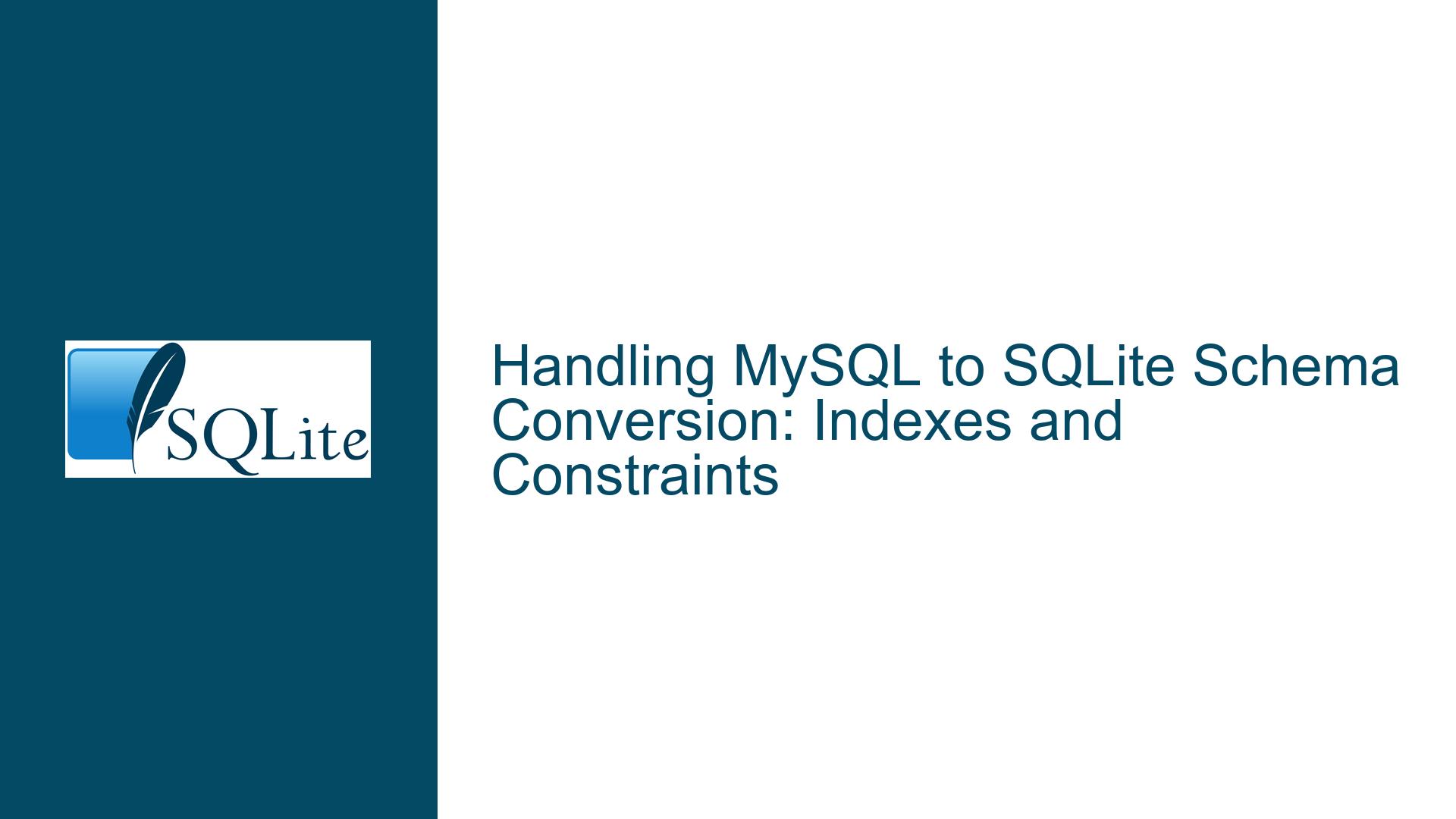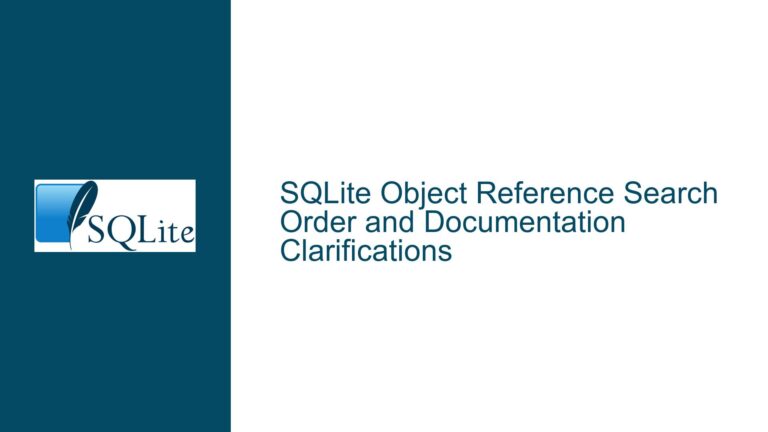Handling MySQL to SQLite Schema Conversion: Indexes and Constraints
Migrating MySQL Schemas to SQLite: Addressing Syntax Differences in Index and Constraint Definitions
MySQL Schema Export Limitations in SQLite: Index and Constraint Syntax Mismatch
Issue Overview
The core challenge arises from fundamental differences in how MySQL and SQLite handle table schema definitions, particularly regarding index creation and constraint enforcement. MySQL allows developers to define indexes directly within the CREATE TABLE statement using clauses like INDEX idx_name (column) USING BTREE, while SQLite requires indexes to be created separately via CREATE INDEX statements after the table is defined. This discrepancy causes schema import failures when attempting to use MySQL-generated .sql dumps in SQLite.
In the provided example, the MySQL CREATE TABLE statement includes four INDEX definitions alongside the PRIMARY KEY. SQLite rejects these inline index declarations, forcing manual separation of index creation into individual CREATE INDEX commands. Additionally, MySQL-specific features like USING BTREE (which specifies the index algorithm) are irrelevant in SQLite, as it uses a B-tree structure by default for all indexes.
The broader implications extend beyond syntax differences. MySQL and SQLite differ in their handling of data types, constraint enforcement timing, and foreign key declarations. For instance, SQLite’s type affinity system may interpret MySQL data types like varchar(32) or int(11) differently, potentially leading to unintended column behavior. Constraints such as UNIQUE or FOREIGN KEY also require careful validation during migration, as SQLite’s deferred constraint checking can affect data insertion workflows.
Root Causes of Schema Import Failures
Inline Index Definitions:
MySQL permits index creation withinCREATE TABLEstatements usingINDEXorKEYclauses. SQLite lacks this syntax, requiring explicitCREATE INDEXcommands post-table creation.Constraint Enforcement Timing:
SQLite evaluates constraints likeUNIQUEorPRIMARY KEYat the time of data insertion. If indexes enforcing these constraints are created after data insertion, invalid data may already exist in the table. Conversely, creating indexes before insertion ensures immediate constraint checks but slows down bulk inserts due to repeated index updates.MySQL-Specific Syntax Elements:
USING BTREE: Redundant in SQLite, which uses B-trees exclusively.- Backtick-quoted identifiers (
- Data type nuances: MySQL’s
int(11)orvarchar(50)are not strictly enforced in SQLite due to its dynamic typing.
Foreign Key Handling:
MySQL’sFOREIGN KEYconstraints may includeON DELETEorON UPDATEclauses that SQLite supports but requires enabling viaPRAGMA foreign_keys = ON;.Transaction and Performance Settings:
Bulk data imports in SQLite benefit from wrapping operations in transactions to minimize disk I/O. MySQL dumps may lack these optimizations, leading to slower imports.
Comprehensive Migration Strategy and Solutions
Step 1: Schema Translation
1.1 Separate Index Creation
Rewrite MySQL CREATE TABLE statements to exclude inline index definitions. Instead, generate standalone CREATE INDEX commands:
-- Original MySQL snippet with inline indexes
CREATE TABLE onl_cgform_button (
...
PRIMARY KEY (`ID`) USING BTREE,
INDEX `idx_ocb_CGFORM_HEAD_ID`(`CGFORM_HEAD_ID`) USING BTREE
);
-- SQLite-compatible version
CREATE TABLE onl_cgform_button (...);
CREATE INDEX idx_ocb_CGFORM_HEAD_ID ON onl_cgform_button (CGFORM_HEAD_ID);
1.2 Normalize Data Types
Convert MySQL-specific data types to SQLite-compatible equivalents:
int(11)→INTEGERvarchar(255)→TEXT- Remove display widths (e.g.,
varchar(50)→TEXT).
1.3 Adjust Constraints
Ensure constraints like NOT NULL, UNIQUE, and DEFAULT are preserved. For foreign keys, explicitly define them in the CREATE TABLE statement:
-- MySQL
CREATE TABLE child (
parent_id INT,
FOREIGN KEY (parent_id) REFERENCES parent(id)
);
-- SQLite
CREATE TABLE child (
parent_id INTEGER,
FOREIGN KEY (parent_id) REFERENCES parent(id)
);
Step 2: Optimize Data Import Workflow
2.1 Insert Data Before Creating Indexes
To maximize import speed:
- Create tables without indexes.
- Import data using
INSERTstatements. - Create indexes afterward.
This approach avoids incremental index updates during bulk inserts. For example:
BEGIN TRANSACTION;
-- 1. Create table
CREATE TABLE onl_cgform_button (...);
-- 2. Insert data
INSERT INTO onl_cgform_button ...;
-- 3. Create indexes
CREATE INDEX idx_ocb_CGFORM_HEAD_ID ...;
COMMIT;
2.2 Use Transactions
Wrap the entire import process in a transaction to reduce disk write overhead:
BEGIN TRANSACTION;
-- Schema and data import steps
COMMIT;
2.3 Disable Foreign Key Checks Temporarily
If foreign keys are involved, disable enforcement during import:
PRAGMA foreign_keys = OFF;
-- Perform imports
PRAGMA foreign_keys = ON;
Step 3: Automate Schema Conversion
3.1 Use Conversion Tools
Leverage tools like sqlite3’s .dump command or third-party converters:
- mysqldump-to-sqlite3: A Python script that converts MySQL dumps to SQLite-compatible SQL.
- pgloader: Supports MySQL-to-SQLite migrations with automated type conversions.
3.2 Script Custom Replacements
For repetitive patterns (e.g., removing USING BTREE), use sed or awk:
sed -E 's/USING BTREE//g; s/`//g' mysql_dump.sql > sqlite_compatible.sql
3.3 Validate Constraints Post-Import
After importing data and creating indexes, run integrity checks:
PRAGMA quick_check;
Step 4: Handle Edge Cases
4.1 AUTO_INCREMENT vs AUTOINCREMENT
Replace MySQL’s AUTO_INCREMENT with SQLite’s AUTOINCREMENT, noting that SQLite uses INTEGER PRIMARY KEY for row IDs:
-- MySQL
CREATE TABLE t (id INT PRIMARY KEY AUTO_INCREMENT);
-- SQLite
CREATE TABLE t (id INTEGER PRIMARY KEY AUTOINCREMENT);
4.2 Character Set and Collation
Remove MySQL-specific CHARACTER SET or COLLATE clauses, as SQLite does not support them:
-- Remove this
`BUTTON_CODE` varchar(50) CHARACTER SET utf8mb4 COLLATE utf8mb4_unicode_ci
-- Keep this
`BUTTON_CODE` TEXT
4.3 Default Values
Ensure default values are compatible. SQLite does not support functions like CURRENT_TIMESTAMP in DEFAULT clauses for TEXT columns unless the column is explicitly marked as DATETIME.
Step 5: Performance Tuning
5.1 Adjust SQLite Settings
Before importing, configure SQLite for bulk operations:
PRAGMA journal_mode = MEMORY; -- Store rollback journal in RAM
PRAGMA synchronous = OFF; -- Reduce disk synchronization
5.2 Batch INSERT Statements
Combine multiple INSERT statements into batches to minimize parsing overhead:
INSERT INTO table VALUES (1), (2), (3);
5.3 Vacuum After Import
Reclaim disk space and optimize the database file post-import:
VACUUM;
Final Recommendations
- Test Schema and Data Integrity: After conversion, verify that indexes are used correctly via
EXPLAIN QUERY PLAN. - Benchmark Import Times: Compare importing with indexes created before versus after data insertion.
- Document Conversion Steps: Maintain a script for repeatable migrations, especially if regular imports are needed.
By systematically addressing syntax disparities, optimizing data import workflows, and leveraging automation tools, developers can efficiently migrate MySQL databases to SQLite while preserving data integrity and query performance.






